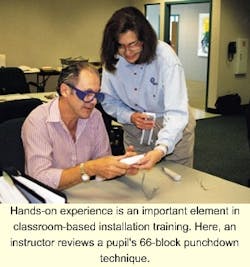Cabling programs at community colleges prepare students well and beef up the labor pool.
Lynn Haber
If you're looking for a place to hit the books for training as a cabling installer, the community colleges in your state might be the best find around. As the need for cabling installers skyrockets, community colleges around the country are beefing up their course offerings and opening their doors to training programs.
While no statistics were available on just how many installer programs are popping up at community colleges around the nation, spokespeople in both academia and the cabling industry agree that local two-year public institutions offer more cabling-installer programs than ever before. They also note that the level of interest from those schools not currently offering programs has risen.
These public schools not only offer a range of programs-some certificate, some degree-but they also offer lower cost compared to the same courses offered at commercial training facilities. And the quality is at least as good, they say.
In fact, according to a spokesman at Bell South, the cabling-installation graduates he has hired from Central Carolina Community College's North Carolina School of Telecommu-nications (NCST-Sanford, NC) have been a great match for the company. "No other school has given me the quality I need for installation and maintenance," he says.
Market spurs demand
Talk to the myriad of players in the telecommunications industry and the message is the same: There is a dire need for new talent. In some cases, companies in the telecom industry are seeing an aging employee base as well as the impending need to replenish those workers heading for retirement. In other cases, the industry and market are simply growing quickly, and there's a corresponding need for cabling installers to fill new positions.
Whatever the scenario, the existing pool of talent isn't enough to fulfill job demands, creating a win-win situation for the community colleges and communications industries.
At the community college level, many schools have been given a directive to provide students with an education that will get them into the labor force and into jobs upon graduation. Schools have noticed the success of community colleges that offer technical telecommunications training and look for similar success, as well.
"Over the last two years, we've had several community colleges talk to us about their interest in modeling a telecommunications program after ours," says John Highhouse, program director of telecommunications training at the Telecommuni-cations Training Dept. of Lincoln Trail College (Robinson, IL). Lincoln Trail College has offered the telecommunications-training program since 1975.
According to Highhouse, other community colleges have taken note of his school's success with job placement and are interested in achieving similar results. "It's been difficult for telecommunications firms to find qualified applicants," he says. "We've had 100% placement over the last six years."
Partnerships bear fruit
A number of players in the cabling-installation field are partnering with community colleges to help fill the industry's payrolls, including both telecommunications companies and commercial training companies.
BellSouth, for example, has preferred to work with community colleges that offer one-year programs, but also works with some offering two-year programs. The company works with others in the industry to establish the program criteria at these schools to ensure graduates have the instruction they need so they can make a smooth transition to the workforce. According to a Bell spokesman, the company has gone so far as to train people from the community colleges in course curriculum. "This approach helps both us and the schools," he says. In some cases, the industry also provides community colleges with seed money to help launch programs.
C-Tech Associates Inc. (Sparta, NJ) and CrossBow Communications Inc. (Fremont, CA), both private commercial-training organizations, also exemplify the partnering taking place to increase cabling-installer training at community colleges.
Four years ago, C-Tech developed a cabling curriculum for copper cable and one for fiber-optic cable. At the time, the company got Lucent Technologies (Murray Hill, NJ) as a partner in the certification process. Lucent has since pulled out of the joint certification process, but the training company has created other industry ties for its courses, which it offers at 160 facilities-half of which are community colleges. Over the past three years, C-Tech has issued program certificates to more than 3,000 students. A litte more than half that total, or about 1,800, graduated in the past year.
CrossBow, which considers itself a standards-based training facility with a mission to provide the West Coast with an independently operated telecommunications training center, teaches cabling installation courses from BICSI (Tampa, FL). The program is recognized by the University of California Extension system, the University of California at Berkeley Extension, and the University of Santa Cruz Extension, according to Bruce Phillips, CrossBow's vice president of operations.
"We find there is a great need for cable installers. And for people at the junior college level who are looking for a career, this program offers them a great career opportunity," Phillips says. He notes that his company is working with a number of two-year colleges, including The College at San Mateo, Canata College, and Foothill College. CrossBow's relationship with community colleges is just a few months old. "We're looking to expand throughout California and west of Denver," he adds.
The number of calls coming into BICSI to find out more about teaching its installer programs at community colleges and about how to set up classrooms has been growing, says Richard Dunfee, manager of BICSI's installation program. "Many of these schools dwell on packaged programs, like Cisco routers or Microsoft certification. But many have come to realize that they don't have a whole lot of knowledge about cabling," he says.
He points out that BICSI is helping some public two-year institutions learn how to use and teach BICSI courses to develop their own programs.
The attraction
There's no mystery as to why community colleges are seeing a swell in enrollment for cabling installer training: The cost is right and a job upon course completion is virtually guaranteed. Furthermore, community colleges offer students a range of courses, from shorter certificate programs and one-year diploma programs to two-year associates degrees.
NCST, for example, offers two program options. Incoming students can sign up for either a certificate program in telecommunications installation and maintenance, or they can enter a diploma program. The certificate program is one semester long, or 14 credit hours, and prepares individuals for jobs in the telecom industry by requiring coursework in basic electricity, cable splicing, fiber optics, local-area-network (LAN) copper cable, cable-fault location and repair, central-office administration, and other topics. According to Janet Gresham, an instructor at NCST, the program emphasizes hands-on training.
By contrast, the diploma program takes three semesters to complete, with a total of 75 credit hours. In addition to the coursework required in the certificate program, diploma students must take literacy, finance, and mathematics courses and choose from among a number of major elective courses. Electives include cooperative work experience, pole climbing, industrial safety, and basic computer-aided design.
Both programs include copper LAN cable, which is an approved course for BICSI's apprentice-level program. "The certificate program is pretty extensive," Gresham says. "Any student who completes it can sit for the BICSI exam and get BICSI-certified at the apprentice level, as well."
Upon graduation from either of NCST's two programs, students can seek jobs from central-office work to troubleshooting, construction, and repair for an end-user organization. The certificate program comprises two shifts-a morning shift from 8:30 AM to 12:30 PM and an afternoon shift from 12:30 to 6 PM-five days a week. The school currently carries 72 students per semester, with 36 students in each shift.
Two years ago, the school began the double-shift operation to accommodate a growing number of incoming students. "We have a waiting list for this program every semester," says Gresham. Currently, the school has more than 100 people overall on the list for its telecommunications program.
Not only does NCST provide students with rich instruction and a career path, but it also offers value. The cost to attend the certificate program, including the BICSI training, is $392.50 for state residents. Students also pay an additional $300 for books and another $150 to sit for the BICSI exam if they so choose. These programs are also available to out-of-state residents at a fee of $2,394.50 plus books.
Both Northwest Technical College (NWTC-Wadena, MN) and Lincoln Trail College have programs for cable installers. NWTC offers one- and two-year telecommunications programs covering basic electronics; outside-plant construction for cable TV and telephony; fiber optics, including splicing, cabling, termination, and testing; key telephone systems; central-office equipment fundamentals; and broadband TV systems design, layout, and troubleshooting. According to Les Schwartz, telecommunications department chair and instructor at NWTC, the one-year program concludes with a diploma, while students of the two-year program earn an Associates of Applied Science (AAS) degree.
To show how community colleges are keeping up with industry trends, NWTC recently combined the study of cable TV and telephony, which second-year students are required to take. "We have an advisory committee of industry people that make curriculum recommendations," Schwartz says, noting that the combined curriculum was a recent recommendation.
The main cabling-installation program at Lincoln Trail College is a two-year AAS program. The school also offers a two-semester certificate in outside-plant and interconnect studies.
Other community colleges around the country also offer training for cabling installers. For example, Tallahassee Community College in Florida offers two courses in conjunction with C-Tech-one in copper and the other in fiber optics.
Hillsboro Community College in Tampa, FL, just finished its first cabling course, which includes the BICSI curriculum. The program is part of a job-skills training program with a primary objective of training students for employment.
Green lights ahead
In addition to reporting a steady flow of students through their cable installation programs, most community colleges have experienced dramatic increases in the number of students applying for and completing the available programs. And, as is the case with NCST, waiting lists are common. The reason: Job opportunity upon graduation is terrific.
"Companies all over the country come to talk to our students," says NWTC's Schwartz. He also reports that he gets calls for three or four employment opportunities per week.
According to the schools, a broad range of employers is looking for their qualified graduates. Firms into which students typically enter include large telephone companies, cellular telephone companies, independent operators or cooperatives, cable-TV companies, competitive local-exchange carriers, interconnect companies, and private companies such as structured wiring contractors and vendors.
Gary Schnick, implementations supervisor for engineering services at Siecor LLC (Hickory, NC), has hired students graduating from community college programs. "We like these students to have a degree in science or engineering with an interest in fiber optics or telecommunications," he says. His primary concern is to get people who have not developed any ingrained work habits, so that they can learn Siecor's way of working in the cabling industry. "We train them after they've finished their community college programs," he says.
A small independent LEC (ILEC), Perry Spencer Rural Telephone Corp. (St. Meirad, IN), has hired graduates from Lincoln Trail's telecommunication program for outside-plant jobs. "Currently, eight of our 11 technicians are graduates of Lincoln Trail," says Paul Dauby, plant manager at the ILEC, noting that he prefers to find employees from the community college rather than hire off the street. "The students are well-rounded," he says.
With the market opportunity growing and jobs abundant in communications industries, reports on all fronts make it clear that community colleges have become the latest training ground for tomorrow's cabling installers. "Community colleges are affordable and their students are better prepared to go into the job market or onto the next level of education," says BICSI's Dunfee.
Lynn Haber is a freelance writer specializing in networking and telecommunications issues.


